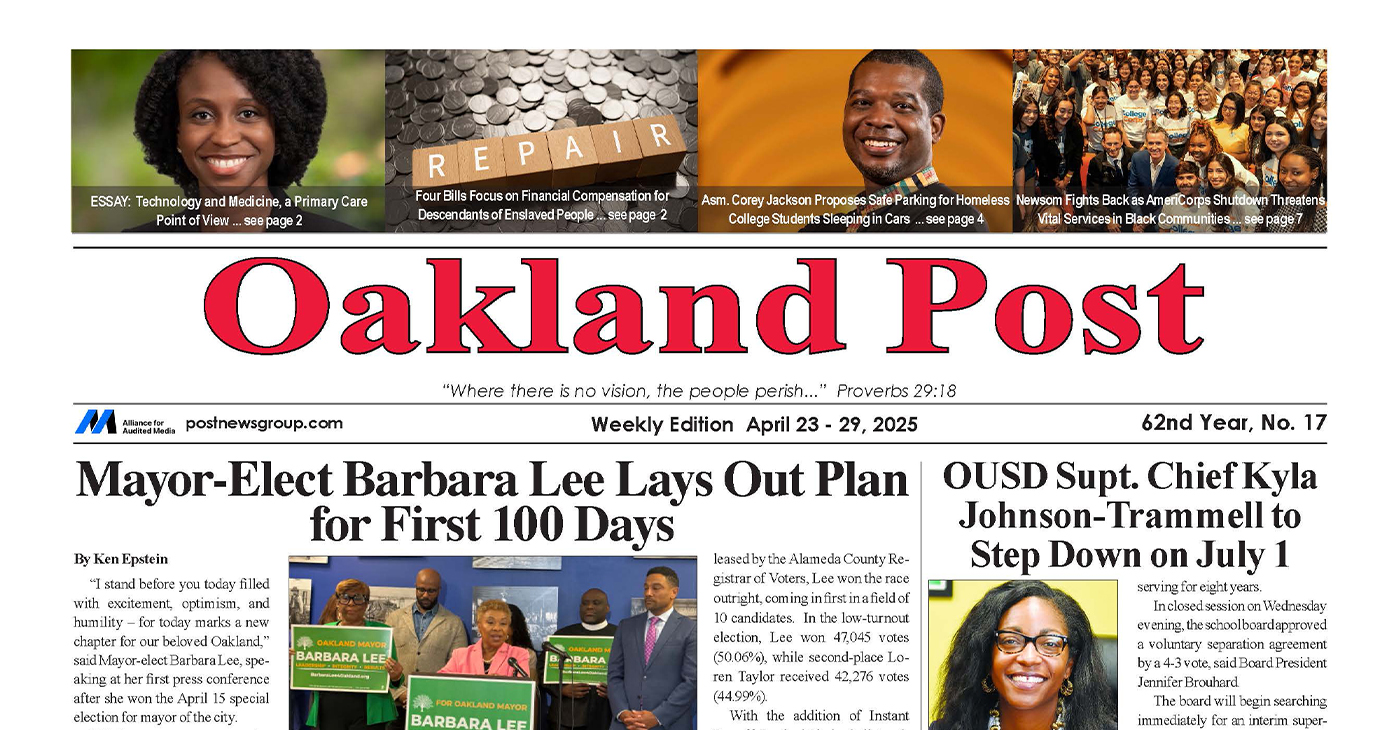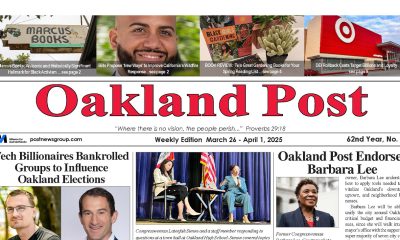Community
Where Can Oakland’s Homeless Park Their Vehicles?

Many Oakland residents who live in vehicles wonder where they can feel safe as city run and sponsored safe parking sites have been inaccessible to them.
“This is a crisis,” said Councilmember Nikki Fortunado Bas during a city council meeting on Oct 1. “The largest growth of [Oakland’s] unhoused residents is people living in their cars and RVs.”
Bas then cited an official count of 1,558 Oakland residents who live in vehicles.
In reports written from Oct 15 to 25 2018, the City Administration of Oakland laid plans to use federal funds to provide up to 200 safe parking spots for unhoused Oakland residents who live in vehicles. After about a year around 50 vehicles are using the programs. The reports proposed four city run sites of which two are currently open and five city sponsored sites in church parking lots, of which two are also currently open.
“People living in RVs often fear their vehicles will be towed due to expired registration or unpaid parking tickets,” wrote assistant city administrator Joe DeVries in a report regarding homeless services. “If an RV is towed, the cost to retrieve it is so prohibitive that it often means the person ends up living on the street.”
But the city of Oakland is still towing unhoused peoples’ vehicles as five of the nine proposed safe parking sites remain unopened. During recent evictions the city towed lifelong Oakland residents Anthony Thompkins’ and Dre Nash’s vehicles which had served as their homes.
At Oakland’s city council meeting on Oct 1, council president Rebecca Kaplan and Councilmember Bas sponsored an emergency ordinance that declared a shelter crisis which allows the city more flexibility in how it can use public space to house its residents. The ordinance renewed a previous shelter crisis declaration but also included a new paragraph that would have required the city to open parking sites for inoperable vehicles and to use city funds to tow and repair these vehicles at the sites.
“Until such designated allowable parking is identified” the paragraph reads, “the city shall refrain from towing such vehicles.”
The additional paragraph within the emergency ordinance would have made the city unable to tow homeless people’s vehicles to impound lots but was removed before the final vote which, as an emergency ordinance, required all six attending city council members’ approval.
“We’re striking that one paragraph regarding towing,” said Council President Kaplan at the Oct 1 meeting, “until further discussions can happen about that and the towing policy can come back as a separate item.”
Councilmember Larry Reid voiced skepticism at the meeting while addressing Kaplan about the services for RVs.
“The more and more service you provide,” said Reid, “the more and more people from outside of Oakland are going to come and inundate the streets with these raggedy RVs.”
The additional services could be helpful for Andre Franklin and Gary Watson, lifelong Oakland residents who live in vans by Lake Merritt. Franklin claims he was stunned on Oct 5 when an Oakland Police officer told him that he planned to tow Franklin’s vehicle that he allows Watson to live in for not being properly registered. After the officer called a tow truck a local resident, Angela Shannon, who was passing by at the time of the incident, parked her vehicle between the tow truck and Franklin’s van, making it impossible to reach, and proposed alternative options to the officer.
When an additional officer showed up, he suggested calling a number for Pastor Ken Chambers, who helps organize safe parking sites in church parking lots through the city sponsored program run by the Interfaith Council of Alameda County (ICAC), to ask if Watson could move there with the van. But the move was impossible because the van was inoperable and even if it wasn’t, the program requires that residents move their vehicles every morning at 7am. Watson has disabilities that make driving impossible. The officers decided not to tow the vehicle.
Although the City of Oakland’s and ICAC planned to offer 50 safe parking spots only 18 people are currently registered with the program. Chambers is seeking more people who need shelter. While the site rules including no alcohol, drugs, cooking or pets dissuade some people, Chambers thinks others don’t yet know about the site.
“We’ve been doing outreach with a shoestring budget,” said Chambers, “but we have to do that because if you build a program they will come but first they have to know about it.”
Residents interested in the program can visit interfaithac.org/safecarpark to register for the program which allows parking from 7pm to 7am everyday. People can also show up to West Side Missionary Church at 732 Willow Street in West Oakland any day at 7pm to register in person.
Activism
Oakland Post: Week of April 23 – 29, 2025
The printed Weekly Edition of the Oakland Post: Week of April 23 – 29, 2025

To enlarge your view of this issue, use the slider, magnifying glass icon or full page icon in the lower right corner of the browser window.
#NNPA BlackPress
Chavis and Bryant Lead Charge as Target Boycott Grows
BLACKPRESSUSA NEWSWIRE — Surrounded by civil rights leaders, economists, educators, and activists, Bryant declared the Black community’s power to hold corporations accountable for broken promises.

By Stacy M. Brown
BlackPressUSA.com Senior National Correspondent
Calling for continued economic action and community solidarity, Dr. Jamal H. Bryant launched the second phase of the national boycott against retail giant Target this week at New Birth Missionary Baptist Church in Atlanta. Surrounded by civil rights leaders, economists, educators, and activists, Bryant declared the Black community’s power to hold corporations accountable for broken promises. “They said they were going to invest in Black communities. They said it — not us,” Bryant told the packed sanctuary. “Now they want to break those promises quietly. That ends tonight.” The town hall marked the conclusion of Bryant’s 40-day “Target fast,” initiated on March 3 after Target pulled back its Diversity, Equity, and Inclusion (DEI) commitments. Among those was a public pledge to spend $2 billion with Black-owned businesses by 2025—a pledge Bryant said was made voluntarily in the wake of George Floyd’s murder in 2020.“No company would dare do to the Jewish or Asian communities what they’ve done to us,” Bryant said. “They think they can get away with it. But not this time.”
The evening featured voices from national movements, including civil rights icon and National Newspaper Publishers Association (NNPA) President & CEO Dr. Benjamin F. Chavis Jr., who reinforced the need for sustained consciousness and collective media engagement. The NNPA is the trade association of the 250 African American newspapers and media companies known as The Black Press of America. “On the front page of all of our papers this week will be the announcement that the boycott continues all over the United States,” said Chavis. “I would hope that everyone would subscribe to a Black newspaper, a Black-owned newspaper, subscribe to an economic development program — because the consciousness that we need has to be constantly fed.” Chavis warned against the bombardment of negativity and urged the community to stay engaged beyond single events. “You can come to an event and get that consciousness and then lose it tomorrow,” he said. “We’re bombarded with all of the disgust and hopelessness. But I believe that starting tonight, going forward, we should be more conscious about how we help one another.”
He added, “We can attain and gain a lot more ground even during this period if we turn to each other rather than turning on each other.” Other speakers included Tamika Mallory, Dr. David Johns, Dr. Rashad Richey, educator Dr. Karri Bryant, and U.S. Black Chambers President Ron Busby. Each speaker echoed Bryant’s demand that economic protests be paired with reinvestment in Black businesses and communities. “We are the moral consciousness of this country,” Bryant said. “When we move, the whole nation moves.” Sixteen-year-old William Moore Jr., the youngest attendee, captured the crowd with a challenge to reach younger generations through social media and direct engagement. “If we want to grow this movement, we have to push this narrative in a way that connects,” he said.
Dr. Johns stressed reclaiming cultural identity and resisting systems designed to keep communities uninformed and divided. “We don’t need validation from corporations. We need to teach our children who they are and support each other with love,” he said. Busby directed attendees to platforms like ByBlack.us, a digital directory of over 150,000 Black-owned businesses, encouraging them to shift their dollars from corporations like Target to Black enterprises. Bryant closed by urging the audience to register at targetfast.org, which will soon be renamed to reflect the expanding boycott movement. “They played on our sympathies in 2020. But now we know better,” Bryant said. “And now, we move.”
#NNPA BlackPress
The Department of Education is Collecting Delinquent Student Loan Debt
BLACKPRESSUSA NEWSWIRE — the Department of Education will withhold money from tax refunds and Social Security benefits, garnish federal employee wages, and withhold federal pensions from people who have defaulted on their student loan debt.

By April Ryan
Trump Targets Wages for Forgiven Student Debt
The Department of Education, which the Trump administration is working to abolish, will now serve as the collection agency for delinquent student loan debt for 5.3 million people who the administration says are delinquent and owe at least a year’s worth of student loan payments. “It is a liability to taxpayers,” says White House Press Secretary Karoline Leavitt at Tuesday’s White House Press briefing. She also emphasized the student loan federal government portfolio is “worth nearly $1.6 trillion.” The Trump administration says borrowers must repay their loans, and those in “default will face involuntary collections.” Next month, the Department of Education will withhold money from tax refunds and Social Security benefits, garnish federal employee wages, and withhold federal pensions from people who have defaulted on their student loan debt. Leavitt says “we can not “kick the can down the road” any longer.”
Much of this delinquent debt is said to have resulted from the grace period the Biden administration gave for student loan repayment. The grace period initially was set for 12 months but extended into three years, ending September 30, 2024. The Trump administration will begin collecting the delinquent payments starting May 5. Dr. Walter M. Kimbrough, president of Talladega College, told Black Press USA, “We can have that conversation about people paying their loans as long as we talk about the broader income inequality. Put everything on the table, put it on the table, and we can have a conversation.” Kimbrough asserts, “The big picture is that Black people have a fraction of wealth of white so you’re… already starting with a gap and then when you look at higher education, for example, no one talks about Black G.I.’s that didn’t get the G.I. Bill. A lot of people go to school and build wealth for their family…Black people have a fraction of wealth, so you already start with a wide gap.”
According to the Education Data Initiative, https://educationdata.org/average-time-to-repay-student-loans It takes the average borrower 20 years to pay their student loan debt. It also highlights how some professional graduates take over 45 years to repay student loans. A high-profile example of the timeline of student loan repayment is the former president and former First Lady Barack and Michelle Obama, who paid off their student loans by 2005 while in their 40s. On a related note, then-president Joe Biden spent much time haggling with progressives and Democratic leaders like Senators Elizabeth Warren and Chuck Schumer on Capitol Hill about whether and how student loan forgiveness would even happen.
-

 Activism4 weeks ago
Activism4 weeks agoOakland Post Endorses Barbara Lee
-

 Activism4 weeks ago
Activism4 weeks agoOakland Post: Week of March 28 – April 1, 2025
-

 Activism3 weeks ago
Activism3 weeks agoOakland Post: Week of April 2 – 8, 2025
-

 #NNPA BlackPress3 weeks ago
#NNPA BlackPress3 weeks agoTrump Profits, Black America Pays the Price
-

 Activism2 weeks ago
Activism2 weeks agoOakland Post: Week of April 9 – 15, 2025
-

 #NNPA BlackPress3 weeks ago
#NNPA BlackPress3 weeks agoHarriet Tubman Scrubbed; DEI Dismantled
-

 #NNPA BlackPress3 weeks ago
#NNPA BlackPress3 weeks agoTrump Targets a Slavery Removal from the National Museum of African-American History and Culture
-

 #NNPA BlackPress3 weeks ago
#NNPA BlackPress3 weeks agoLawmakers Greenlight Reparations Study for Descendants of Enslaved Marylanders























































